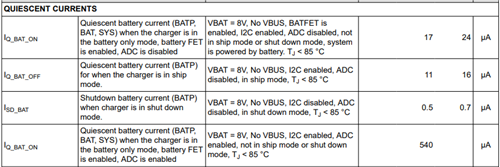Other Parts Discussed in Thread: BQ25792
Hi,
Could you tell me about quiescent battery current in VBUS connected condition?
Customer is using EVM to measure Iq.
In the case of ”VBUS=0V , VBAT=4.86V , Charging stopped state” condition, it was 17 μA.
This matches the data sheet specs.
However, in the case of ”VBUS=5.14V ,VBAT=4.86V, Charging stopped state” condition, quiescent battery current increased.
The actual measurement is about 380 μA.
Could you tell me why quiescent battery current increases with VBUS connected?
And Please advise how to make smaller with VBUS connected.

Regards,
Yusuke

